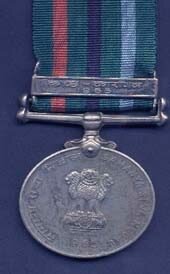|
 Intended as a successor for the General Service Medal 1947 (though the time period of some of the operations seem to overlap?), the General Service Medal, 1965 (or, more properly to avoid confusion, the Samanya Seva Medal, 1965) was awarded for specific services in specified actions which were represented by bars attached to the medal. While all bars observed have been produced in Hindi rather than English, they will frequently be refereed to by their English names. At the request of friends, and since the bars are in Hindi and may therefore present identification problems, I have, where possible, attached close-up images of the bars. I hope this will aid in their identification. Intended as a successor for the General Service Medal 1947 (though the time period of some of the operations seem to overlap?), the General Service Medal, 1965 (or, more properly to avoid confusion, the Samanya Seva Medal, 1965) was awarded for specific services in specified actions which were represented by bars attached to the medal. While all bars observed have been produced in Hindi rather than English, they will frequently be refereed to by their English names. At the request of friends, and since the bars are in Hindi and may therefore present identification problems, I have, where possible, attached close-up images of the bars. I hope this will aid in their identification.
Throughout, and regardless of the specified time periods for qualification decoration, wounds resulting in evacuation, or death in circumstances of active service result in automatic eligibility for the medal and appropriate bar. Likewise, time spent as a prisoner-of-war is allowed to count toward the qualifying period.
Established: 8 May 1975, by the President of India (with effect from 26 January 1965).
Obverse: A circular 35-mm copper-nickel medal. In the center, the state emblem and, to the left "Samanya Seva Medal" in Hindi and to the right "SAMANYA SEVA MEDAL". At the bottom, the date "1965". The medal is suspended by a straight-bar suspender and is usually named on the edge.
Reverse: The Indian elephant badge, drawn from the design of the flag of the Indian president.
Ribbon: 30.5 mm, medium green with three, equally spaced, 3.5 mm stripes of red, dark blue, and light blue. Medium green 5 mm, red 3.5 mm, medium green 5 mm, dark blue 3.5 mm, medium green 5 mm, light blue 3.5 mm, medium green 5 mm. As it has been so common and so widely produced, there is some variability of the precise shades of the colors in this ribbon. These color variations have no significance (as some have stated).

Outline:
-
Kutch Khargil 1965 - instituted on 8 May 1975 (as one of the original bars for the medal), this bar was awarded for actions against Pakistani troops in western India from April 1965 to January 1966 in two widely diverse environments: the salt flats of Kutch (in Gujarat State) or in the Khargil sector of the high Himalayas - Kutch: one day of service in battle between 9 April 1965 and 1 May 1965 or ten days of general services in Kutch between 9 April 1965 and 1 July 1965, air force personnel would qualify by one operational sortie or three hours of flight time - Khargil: one day of service in specific battles in the Khargil sector bwteen 17 May 1965 and 25 January 1966 or 90 days of active service in the area between 17 May 1965 and 25 January 1966, air force personnel would qualify by three operational sorties or ten hours of flying - the precise zones of qualification are specified in the establishing order in excruciating detail and are not given here
-
Nathula Chola (1967) - instituted on 8 May 1975 (as one of the original bars for the medal), this bar was awarded for service along the Sino-Indian border for one day of service in the border incidents at Nathula (11-16 September 1967) or Chola (1 October 1967) - air force personnel would qualify by one operational sortie during these periods
- Nagaland (1975-) - earlier service was recognized by the "Naga Hills" bar to the General Service Medal, 1947
- Mizoram (1975-) - earlier service was recognized by the "Mizo Hills" bar to the General Service Medal, 1947
- Tirap (19??-??) - awarded for service in Tirap district of Arunachal Pradesh?
|





 Intended as a successor for the General Service Medal 1947 (though the time period of some of the operations seem to overlap?), the General Service Medal, 1965 (or, more properly to avoid confusion, the Samanya Seva Medal, 1965) was awarded for specific services in specified actions which were represented by bars attached to the medal. While all bars observed have been produced in Hindi rather than English, they will frequently be refereed to by their English names. At the request of friends, and since the bars are in Hindi and may therefore present identification problems, I have, where possible, attached close-up images of the bars. I hope this will aid in their identification.
Intended as a successor for the General Service Medal 1947 (though the time period of some of the operations seem to overlap?), the General Service Medal, 1965 (or, more properly to avoid confusion, the Samanya Seva Medal, 1965) was awarded for specific services in specified actions which were represented by bars attached to the medal. While all bars observed have been produced in Hindi rather than English, they will frequently be refereed to by their English names. At the request of friends, and since the bars are in Hindi and may therefore present identification problems, I have, where possible, attached close-up images of the bars. I hope this will aid in their identification.